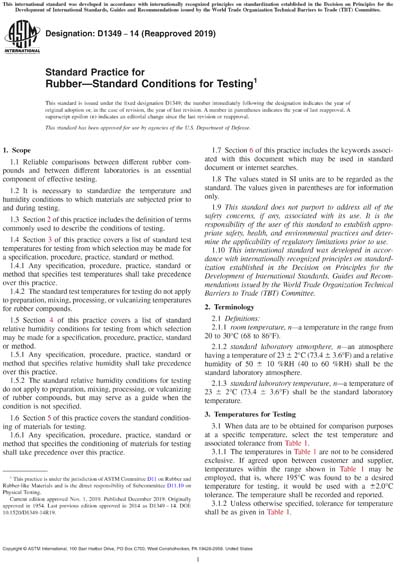Most recent
ASTM D1349-14(2019)
Standard Practice for Rubber—Standard Conditions for Testing
1.1 Reliable comparisons between different rubber compounds and between different laboratories is an essential component of effective testing.
1.2 It is necessary to standardize the temperature and humidity conditions to which materials are subjected prior to and during testing.
1.3 Section 2 of this practice includes the definition of terms commonly used to describe the conditions of testing.
1.4 Section 3 of this practice covers a list of standard test temperatures for testing from which selection may be made for a specification, procedure, practice, standard or method.
1.4.1 Any specification, procedure, practice, standard or method that specifies test temperatures shall take precedence over this practice.
1.4.2 The standard test temperatures for testing do not apply to preparation, mixing, processing, or vulcanizing temperatures for rubber compounds.
1.5 Section 4 of this practice covers a list of standard relative humidity conditions for testing from which selection may be made for a specification, procedure, practice, standard or method.
1.5.1 Any specification, procedure, practice, standard or method that specifies relative humidity shall take precedence over this practice.
1.5.2 The standard relative humidity conditions for testing do not apply to preparation, mixing, processing, or vulcanizing of rubber compounds, but may serve as a guide when the condition is not specified.
1.6 Section 5 of this practice covers the standard conditioning of materials for testing.
1.6.1 Any specification, procedure, practice, standard or method that specifies the conditioning of materials for testing shall take precedence over this practice.
1.7 Section 6 of this practice includes the keywords associated with this document which may be used in standard document or internet searches.
1.8 The values stated in SI units are to be regarded as the standard. The values given in parentheses are for information only.
1.9 This standard does not purport to address all of the safety concerns, if any, associated with its use. It is the responsibility of the user of this standard to establish appropriate safety, health, and environmental practices and determine the applicability of regulatory limitations prior to use.
1.10 This international standard was developed in accordance with internationally recognized principles on standardization established in the Decision on Principles for the Development of International Standards, Guides and Recommendations issued by the World Trade Organization Technical Barriers to Trade (TBT) Committee.
Content Provider
ASTM International [astm]






